Key Takeaways
- Faced with student retention and college completion challenges, Sinclair Community College began a years-long plan to improve both.
- The Student Success Plan software provides a holistic case-management system that partners faculty, advisors, counselors, and students in helping students successfully complete their college careers.
- Following receipt of a Next Generation Learning Challenges Wave 1 grant, Sinclair is converting SSP to open-source software and setting up a nonprofit distribution organization to help other colleges adopt the system for their own educational circumstances.
Sinclair Community College [http://www.sinclair.edu/about/history/] has provided affordable, accessible, high-quality college and workforce training for nearly 125 years to students in Dayton Ohio and the surrounding region. Currently the college has six locations across Southwestern Ohio enrolling roughly 26,000 for-credit students. The college’s credo comes directly from founder David A. Sinclair: “Find the need and endeavor to meet it.” The Student Success Plan (SSP) software does exactly that: Developed at Sinclair over the past eight years, it provides a holistic case-management system used by faculty and support staff to engage students, assist them in planning, support them, and help them successfully complete college.
Video interview describing the SSP project (video licensed by ISKME; Creative Commons BY-NC-SA 3.0):
What Is SSP?
SSP is comprehensive student success software designed to increase at-risk student persistence, success, retention, and graduation rates. The system supports wraparound student services, holistic coaching, student alerting, and interventions. Sinclair supports eight distinct student populations and processes with SSP, with Pathways to Completion focusing on first-time “at-risk” students. Through counseling and web-based support systems, students who are at greatest risk of failing in college are identified, supported, and monitored.
Although SSP software can be used to support any student population, it originally targeted “at-risk” students, specifically in areas of under-preparedness for college, poverty, and indecision in choosing a major. Recently updated features have extended support to high school and distance learning students as well. SSP includes case management tools, a journal of all contact with students, early alerts, and an individual action plan. The action plan addresses challenges the student is facing (Figures 1 and 2) and connects them to resources available at the college and in our community (Figure 3). The college and community resources are stored in a customizable counseling intervention guide that is easily and securely updated and maintained through an administrative web-based solution (Figure 4). The web-based SSP software is available at any location to allow advisors, counselors, and coaches to assist students wherever they are.
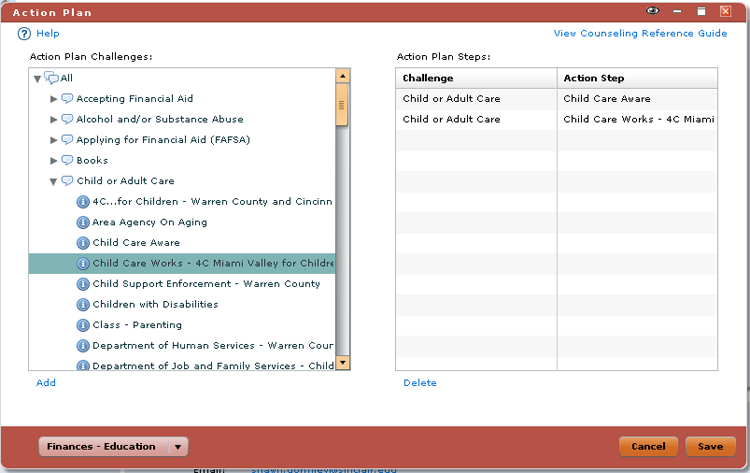
Figure 1. Action Plan Identifying Child Care as a Challenge
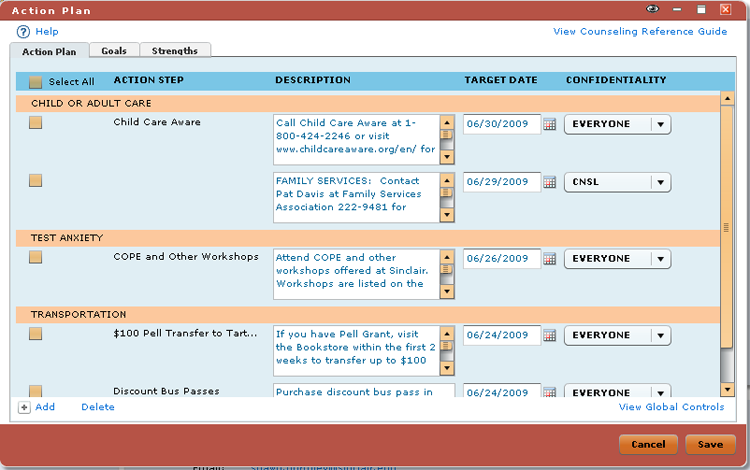
Figure 2. Action Plan with Possible Solutions to Child Care Problem
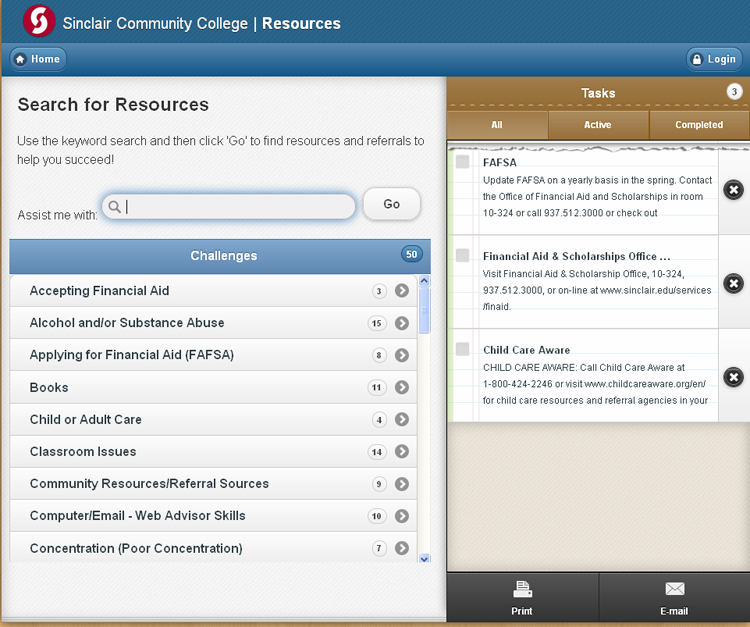
Figure 3. Resources for Challenges, Including Child Care
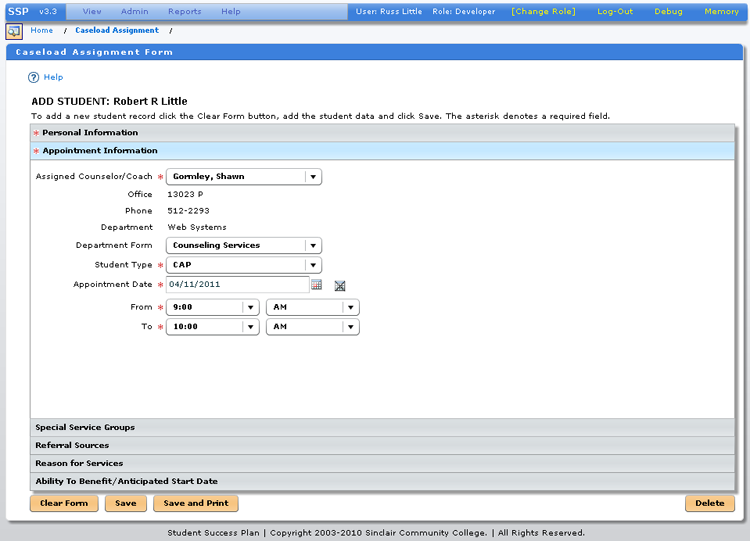
Figure 4. Adding a Student to a Counselor’s Caseload
What Prompted Development of SSP?
Historically, ongoing research by Sinclair’s Research, Analytics, & Reporting Department [http://www.sinclair.edu/about/offices/rar/] reported poor success rates for high-risk students. Furthermore, Sinclair’s student success, retention, and graduation rates were below strategic targets.
Influenced by Terry O’Banion’s Learning College model,1 Sinclair embarked on an intensive self-examination related to improving student success, particularly among students who were most likely to be lost through attrition. Through years of intensive study of our students, we learned that the students most likely to drop out have low academic readiness and skills, financial barriers, a limited sense of their own assets and limitations, some degree of family and social support, and little experience with setting and achieving goals. The concept of providing wraparound or intensive advising to address these concerns emerged from the counseling, student development, and social work disciplines.
Planning
Starting in 2002, Student Services Division and Developmental Studies Department administrators, counselors, and faculty formed a core planning team that:
- Completed a thorough retention literature review, held discussions with national retention experts (Michael Dolence, George Kuh, Hunter Boylan, and Vincent Tinto), and benchmarked best practices in other community colleges
- Focused on retention, identifying at-risk criteria and developing key components for an individual learning plan
- Developed the practical, comprehensive, five-year Student Success Plan
- Wrote a successful $1.825 million, five-year U.S. Department of Education Title III Strengthening Institutions proposal to fund the development and initial implementation, including development of a web-based support system
Identifying At-Risk Students
Our at-risk students have:
- Limited academic readiness
- Minimal college skills
- Financial or employment barriers
- Limited knowledge of personal strengths
- A limited social network or family support system
- Minimal experience setting and tracking personal goals
Incoming students are screened through Assessment Intake based on risk criteria (Figures 5 and 6). Other students are referred to Counseling Services by an academic counselor, faculty, or themselves. Referrals also come from Developmental Studies faculty. All benefit from participation in the Student Success Plan.
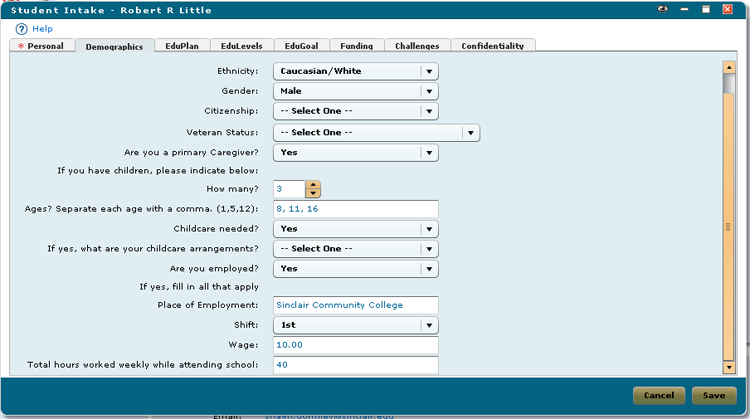
Figure 5. Student Intake Form with Demographic Data
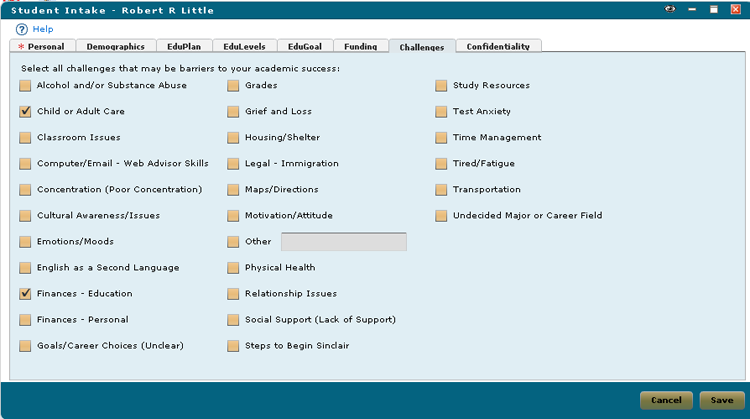
Figure 6. Student Intake Form Identifying Challenges
Intrusive/Preemptive Coaching for At-Risk Population
Pathways to Completion serves as a new student’s personal guide to becoming a successful student. The coach will assist the assigned student with the following:
- Assessment of challenges and strengths
- Planning for payment options
- Academic planning
- Study skills recommendations
- Planning for educational goals and career
- Resource information and referrals
- Multidimensional assessment to fully understand the whole student
At-risk students who participate in the SSP process have a customized, documented action plan to guide their educational experience. New degree- or certificate-seeking students undergo placement testing and are also evaluated for risk criteria (placing into two or more Developmental Studies courses, poverty-level income, undecided major, or working full-time). The SSP software will support any at-risk criteria a college chooses to track and is easily configurable to create new or different designations. Currently enrolled at-risk students are also referred and receive intervention services for not meeting academic and/or financial aid standards of satisfactory progress or through the Developmental Studies and gatekeeper courses early alert (Figures 7 and 8). Integration with the student information system connects student data to SSP, which automatically builds rosters for faculty, supporting the early alert feature.
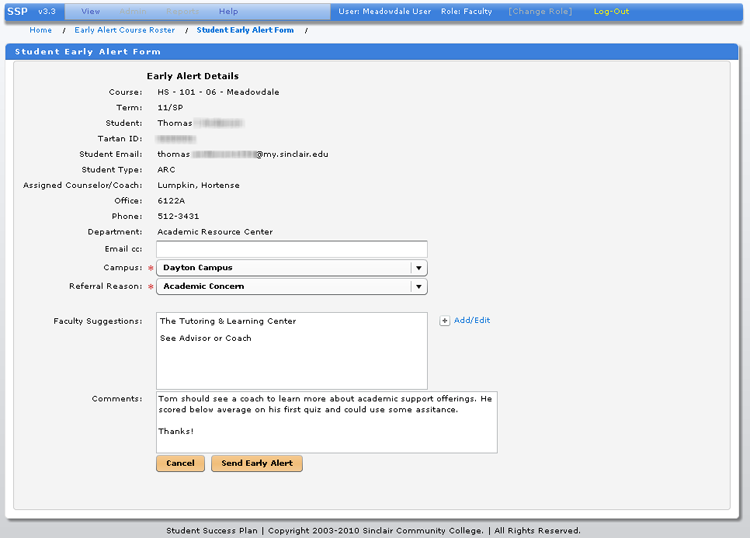
Figure 7. Early Alert Form
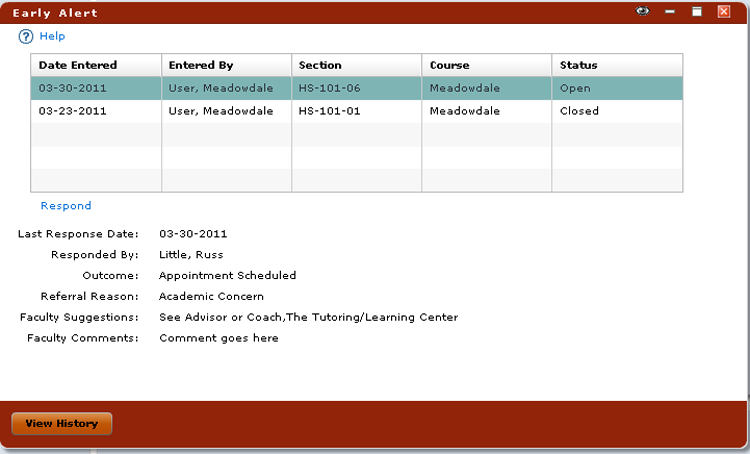
Figure 8. Early Alert Record
Preventive measures and assertive intervention consist of inventorying learning styles and study skills, planning for funding educational expenses, orientation to campus and community resources, orientation to college life, and other services. The holistic advising and coaching techniques use a case management approach to develop trust and relationships between students and advisors. Coaching involves:
- Identification of strengths and weaknesses to design an individualized action plan of activities to support the student’s success
- Sharing of information
- Web-based journaling of progress (Figures 9 and 10)
- Regular appointments
- Online self-help tools (Figure 11)
- Early alerts generated by faculty
- Transition strategies (once students meet transition criteria)
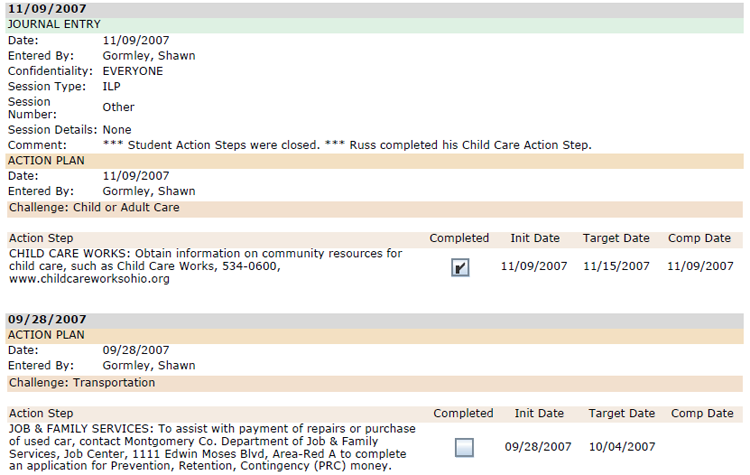
Figure 9. Journal Entry

Figure 10. Journal Record of Actions Taken
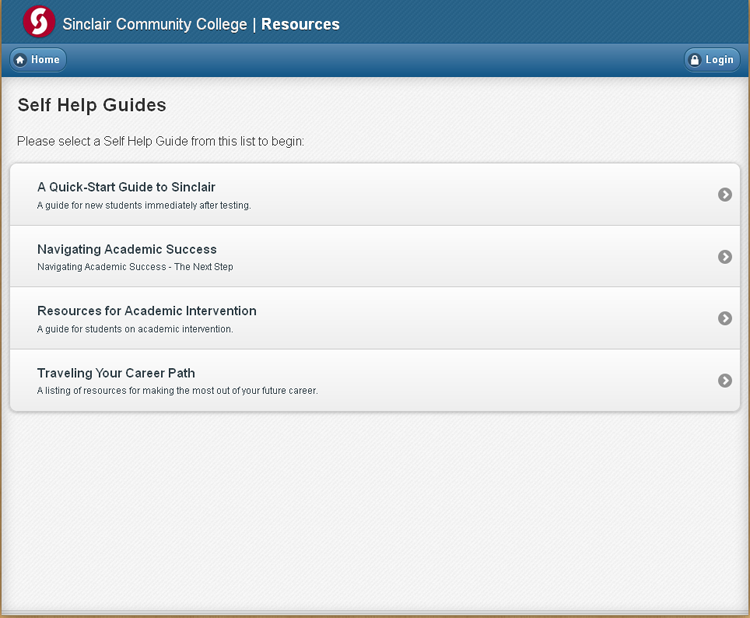
Figure 11. SSP Online Self-Help Guides
Aiding Students with Technology
- Use of next-generation technology (SSP) to diagnose specific needs and implement highly individualized learning plans
- Academic plans for each student that prescribe an individual course enrollment sequence with both near-term (one-year certificate) and longer-term credential milestones (using SSP and MAP2)
- Intrusive advising, attendance, life-skills courses, and declared courses of study linked to career pathways
- Technology to make real-time feedback, intensive advising, accelerated, flexible, and student-centered learning more available
- Early-warning/early-intervention systems used by faculty to monitor student attendance and progress in real time and alert counselors/advisors who then engage the students and support their reentry and success
How Well Does SSP Work?
The Sinclair student information system in conjunction with the SSP’s web-based data entry system offers a comprehensive student monitoring capability. With the help of the campus research department, quarterly data are collected, analyzed, tracked, and reported for trends. On a routine basis, students are surveyed to evaluate the effectiveness of the support programs from their perspective. In addition, advisors meet on a regular basis to continually review and improve processes and referrals.3
The program is additionally enhanced by ongoing collaboration and cross-training with the departments of Financial Aid, Enrollment Services, Academic Advising, and early alert faculty and their respective academic divisions. The greatest ongoing challenge is partnering with the most at-risk students on campus and working with them to become engaged, be proactive, and take responsibility for their learning outcomes. To best accomplish this, case management standardizes processes and coordinates services, referrals, and record keeping.
The SSP software and processes such as Pathways to Completion have a proven and documented track record of success in improving student outcomes. Learner analytics software has been used with thousands of students and has demonstrated SSP’s efficacy in improving the success of low-income, academically unprepared students who struggle with gatekeeper courses. Each year an annual report is conducted by Student Services and Research, Analytics & Reporting to measure our progress and let us reflect on the process and its outcomes. SSP and the Pathways to Completion process involve best practices in community college student services processes and are based on the research in student retention espoused by Noel-Levitz Higher Education Consultants [https://www.noellevitz.com/], Vincent Tinto at Syracuse University, George Kuh at Indiana University, the Community College Survey of Student Engagement from the University of Texas at Austin, and others. These proven practices focus on the models of enrollment management, student engagement, case management, connectedness with the college, and student assessment. Based on consistent internal research over many years, we have found that students participating in Pathways to Completion do better when compared to other first-time degree-seeking students and especially to other Pathways to Completion–qualified students who did not participate. They:
- Are more likely to return the next term
- Are more likely to complete more courses successfully
- Have higher GPAs
- Are more likely to be enrolled two years later
Other notable findings include:
- At-risk racial minority students that transitioned off the SSP services had the highest first-term retention rates of all student groups.
- Low-income Pell Grant recipients had higher term-to-term retention rates across all student groups (except for transitioned students, who had similar retention rates regardless of Pell Grant status).
- From fall 2009 to winter 2010 the term-to-term retention differences between student groups were statistically significant (p < .001).
Web-based support and analytics includes SSP software that uses an SQL database integrated with demographic and admissions information from Sinclair’s SAS data warehouse and provides access to the college’s Datatel Colleague ERP [http://www.datatel.com/products/products_a-z/colleague-erp.cfm] for course registration and grade data. Research data has been reported to the U.S. Department of Education through annual reports and through a series of internal reports produced by the Sinclair Department of Research, Analytics & Reporting.
The Case for Implementing SSP
SSP facilitates fundamental and systemic change within an institution. It develops consistent, web-based student services processes that previously existed in procedures that varied among coaches. The case management approach with web-based case notes and student data can be accessed by any coach working with a student. This software improves the reporting capability and consistency far beyond what is possible with typical handwritten notes, and it is critical for tracking and improving the success of at-risk students.
Coaches have real-time access to student records, journal notes from other coaches, and other department-generated student information. The web-based counseling, record management, reference, and reporting analytics streamline processes by eliminating the need to file and retrieve paper files. Coaches and administrators using SSP have extensive report-generating capabilities (Figure 12).
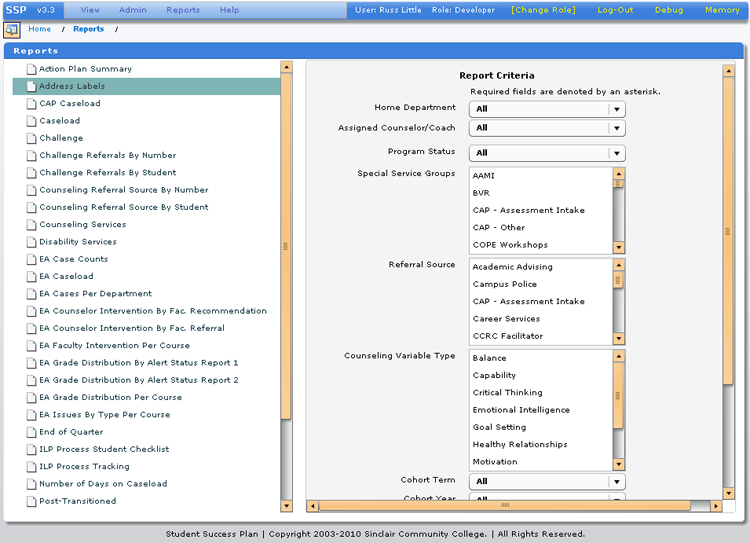
Figure 12. Pulling Reports from SSP
The software supports an early alert intervention with faculty that provides continued feedback to faculty until a student issue is resolved. There is also a student interface — an online self-help guide to assist students in identifying and overcoming roadblocks and detours on their road to success. This tool can also be used for a coach to securely post an individual student’s action plan online for them to refer to and communicate back to the coach when items on the plan are complete.
National Awards to SSP
2004: EDUCAUSE Excellence in Information Technology Solutions Award
2005: Macromedia Higher Education Innovation Award
National Council for Student Development Exemplary Practice Award
NCSD and League for Innovation Terry O’Banion Shared Journey First Place Award
2006: MetLife Best Practice College Award
2007: Bellwether Finalist Award — CC Futures Assembly
2008: NACADA Program Merit Award
NASPA Grand Silver and Gold Awards
2009: NASPA Grand Gold (for Early Alert)
Making SSP available as Open-Source Software
Sinclair recently received a Next Generation Learning Challenge (NGLC) Wave 1 grant to provide the software to other colleges wanting to implement similar student support systems. The NGLC grant will fund:
- Conversion of the SSP to open-source software
- Creation of an open-source organization to manage the growth and development of the software
- Creation of a web portal to support the distribution of the software and management of the open-source community
- Outreach to stimulate colleges to adopt the software
- Building partnerships with colleges and for-profit and nonprofit organizations to construct a vibrant community around SSP
This NGLC-funded project will leverage many years of software development efforts from Sinclair, including the SSP software source code, data analytics processes, research methods, documentation, training program for IT and student services staff, and historical performance data. It is designed to overcome three major barriers to adoption of this type of system:
- The high startup and ongoing costs of commercial case management and early alert tools are a concern for many institutions. Projected future implementation costs should be significantly lower with an open-source platform.
- Sales and technical support are not Sinclair’s core business. We want to build a community of peers, not a client base. We are working to establish relationships with nonprofit and for-profit partners who can provide any needed technical implementation, ongoing support, or consulting services to make the tool successful on different campuses.
- With commercial solutions, colleges typically cannot adapt the software source code to meet their local needs. With open-source code for SSP, future users may make improvements to expand and grow the software. In a collaborative community the software, and community generated improvements, will become available to greater numbers of institutions needing low-cost access to proven student support software.
Sinclair will continue to innovate and advance the SSP software. It is hoped that partner colleges will make similar contributions and that a strong community of practice and technology will emerge. The project also will partner with preferred vendors who can provide technical support and other services to campuses implementing the software. Once the nonprofit organization is operating, it will leverage the expertise of student services professionals and programmers in the expanding community of members. This expertise will foster growth, development, and adoption of the SSP. We invite others to join us as this initiative develops.
Get Involved
We expect to have the open-source version of the SSP software available in July 2012. We are piloting the current version with some schools now. For more information or to see a demo, contact me at [email protected].
- Terry O’Banion, A Learning College for the 21st Century (Phoenix, AZ: Oryx Press, 1997).
- MAP (My Academic Plan) is an electronic academic course plan created between students and advisors that creates a prescriptive path to academic success. This software, also created at Sinclair Community College, is not yet open source.
- Referrals are made through the Counseling Reference Guide included in SSP and available online to coaches and students based on configuration.
© 2011 Russ Little. The text of this EQ article is licensed under the Creative Commons Attribution 3.0 license.
